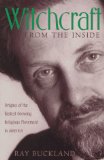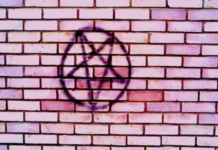
Witchcraft from the Inside: Origins of the Fastest Growing Religious Movement in America
, by Raymond Buckland
Llewellyn Worldwide, 1567181015, 197 pp. (+ bibliography and Iidex), 1974, 1975, 1995
This is a reissue of one of the classics from the days when I began my studies. Because it was originally issued nearly thirty years ago, some of it is rather dated, but there have been appropriate updates in sections which required the most work.
The debates over the origins and meanings of the words “Druid” and “Wica” have occupied a lot of time and energy in the community over the past decades and will undoubtedly continue to do so for more to come. In point of fact, we may never “know for sure” about these topics, and should, in my opinion, be willing to agree to disagree.
Dr. Buckland, following in the steps of Gerald Gardner, spells the name of the religion with only one “c” (Wica) not the more common two “c’s” (Wicca). And, also like Gardner, he makes no distinction between “Wica” and “Witchcraft.” Although many new to the religion will insist that “Wicca” was created by Gerald Gardner and is a religion, and that “Witchcraft” is synonymous with magick (and may be practiced by members of any religion, even Christians), Gardner, Buckland, et. al. make no such distinction.
There have been additions and revisions to the text (and if I could find my misplaced copy of the first paperback printing, I could document many of them). One obvious addition is a drawing of a Seax-Wica altar (on page 139). The Seax (Saxon) tradition did not exist publicly when the book was first published. Later obvious additions, which will be discussed further, are Chapters 11 and 12 (“Whither Wicca?” and “The Teen Interest Plus Feminist Wicca”).
Reading this book took me back to my earliest studies of the religion I have followed now for well over half of my life. I can still remember my feelings of awe as I read books by people who would admit, publicly, to being Witches. Although the political and religious climate have both undergone huge changes in the ensuing three decades plus, it still takes a great deal of courage to come out of the “broom closet.” Although it isn’t supposed to be dangerous to do so, it can still be damaging to one’s reputation, employment, and chances of maintaining custody of one’s children.
I occasionally hear newcomers talk about how much better it was twenty or thirty years ago; about how there wasn’t the oppression and the discord between traditions, as if somehow we have taken steps back from a “Golden Age.” As one who lived through the perceived “Golden Age,” I am here to tell you that if it weren’t for the pioneering work of authors like Dr. Buckland, we wouldn’t have the freedoms we have today. And as for the discord between groups”??? When this book first came out “everybody knows” that the only true Witches were Gardnerians. Everybody else was a bunch of wannabees, and were treated accordingly.
Dr. Buckland acknowledges the discontinuity between the practices of our ancestors and the worship of our groups today (at one point he even admits that drug usage may have had a place in medieval practices). In the ‘70s it was an article of faith that there existed an unbroken line of connection between our modern covens and the ancient beliefs, which is ridiculous.
Dr. Buckland discounts the concept of hereditary Witches, and I dare say many of today’s practitioners would agree with him on that point. In a hold over from previous works he also appears to discount the idea of self-initiation, which I suspect would not find as many in agreement. He does acknowledge the existence of such an initiation, but seems to indicate that it is primarily a “stop-gap” measure intended only to serve until one can be “properly” initiated. He also appears to espouse a different understanding of the term “Elder,” in that he reserves it to Third Degree Witches as opposed to its use (in many groups) to Second and Third Degree members.
Other areas where Dr. Buckland varies from the current crop of writers and teachers of the occult is on the topics of reincarnation and three-fold return. He sees three-fold in terms of the current life only, and not being carried over into future incarnations. Many current “authorities” see it more in terms of karma (the Eastern philosophy of a “balance sheet” carried from one life to another). This provides, in my opinion, a much needed alternative to what has become an increasingly one-sided view. I do have a disappoint-ment that he fails to explain why “pay back” should be on a three-to-one ratio (I have my own opinion on this, but this is not the place to go into that).
Chapters 11 and 12 (“Whither Wicca?” and “The Teen Interest Plus Feminist Wicca”) are welcome additions to the work, especially since neither area had any public existence at the time of the original publication of this work. These two chapters were not written by Dr. Buckland, but were produced by other authors and teachers.
Chapter 11 contains input from three prominent members of the Pagan community (one of whom is a personal acquaintance of this reviewer). It is interesting to see the perspective of other Pagans as regards the development and growth of Wicca.
Ed Fitch has been a mainstay of the Pagan movement for longer than many of today’s practitioners have been alive. I have always looked forward to hearing what he has to share.
While I don’t know Michael Ragan personally, or by his writings, he offers a view of Wicca which has its own value.
Selena Fox I have known, casually, since the mid-‘70s, when Circle was just getting started, and the first “Midwest Pan-Pagan Gathering” was an overnight camp-out in Indiana. She has been involved in the fight for the legal recognition of Paganism for as long as I have known her. She speaks from long years of experience. In all the years I have known Selena, she was worked tirelessly to bring about tolerance ” not just of the “Establishment” for Paganism, but of Paganism for the “Establishment.” She is a living example of what sincere belief can accomplish. “Circle Network News” (the publication she helped establish) has evolved from a few pages of newsprint, dealing mostly with Midwestern groups, to become one of the best, most widely available, longest-lasting publications devoted to Paganism in the world today. She has seen, and been involved with, the evolution of Paganism throughout its public existence in the U.S.
I was pleased to see that rather than giving his interpretation of Feminist Wicca in Chapter 12, Dr. Buckland gave Zsuzsanna Budapest (a well-known, prominent writer and teacher of the Feminist Wiccan movement) an opportunity to explain it from the inside. This is another welcome addition to the current edition.
This is another one of the books which should be in every teacher’s library. You may not agree with everything Buckland says, but you should be aware of how others perceive the movement known as Wicca.








